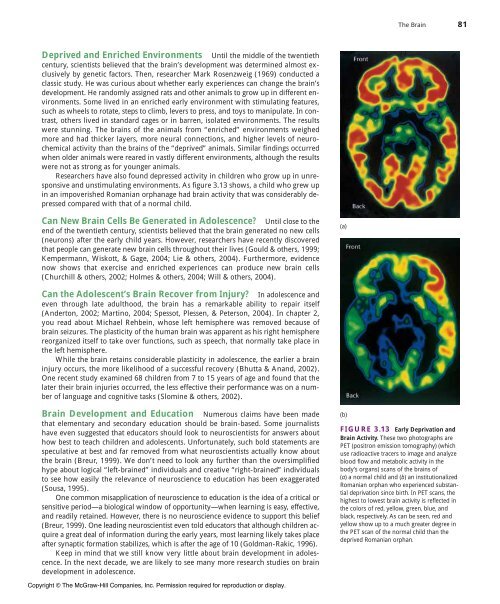Chapter 3 Puberty and Biological Foundations - The McGraw-Hill ...
Chapter 3 Puberty and Biological Foundations - The McGraw-Hill ...
Chapter 3 Puberty and Biological Foundations - The McGraw-Hill ...
Create successful ePaper yourself
Turn your PDF publications into a flip-book with our unique Google optimized e-Paper software.
Deprived <strong>and</strong> Enriched Environments Until the middle of the twentieth<br />
century, scientists believed that the brain’s development was determined almost exclusively<br />
by genetic factors. <strong>The</strong>n, researcher Mark Rosenzweig (1969) conducted a<br />
classic study. He was curious about whether early experiences can change the brain’s<br />
development. He r<strong>and</strong>omly assigned rats <strong>and</strong> other animals to grow up in different environments.<br />
Some lived in an enriched early environment with stimulating features,<br />
such as wheels to rotate, steps to climb, levers to press, <strong>and</strong> toys to manipulate. In contrast,<br />
others lived in st<strong>and</strong>ard cages or in barren, isolated environments. <strong>The</strong> results<br />
were stunning. <strong>The</strong> brains of the animals from “enriched” environments weighed<br />
more <strong>and</strong> had thicker layers, more neural connections, <strong>and</strong> higher levels of neurochemical<br />
activity than the brains of the “deprived” animals. Similar findings occurred<br />
when older animals were reared in vastly different environments, although the results<br />
were not as strong as for younger animals.<br />
Researchers have also found depressed activity in children who grow up in unresponsive<br />
<strong>and</strong> unstimulating environments. As figure 3.13 shows, a child who grew up<br />
in an impoverished Romanian orphanage had brain activity that was considerably depressed<br />
compared with that of a normal child.<br />
Can New Brain Cells Be Generated in Adolescence? Until close to the<br />
end of the twentieth century, scientists believed that the brain generated no new cells<br />
(neurons) after the early child years. However, researchers have recently discovered<br />
that people can generate new brain cells throughout their lives (Gould & others, 1999;<br />
Kempermann, Wiskott, & Gage, 2004; Lie & others, 2004). Furthermore, evidence<br />
now shows that exercise <strong>and</strong> enriched experiences can produce new brain cells<br />
(Churchill & others, 2002; Holmes & others, 2004; Will & others, 2004).<br />
Can the Adolescent’s Brain Recover from Injury? In adolescence <strong>and</strong><br />
even through late adulthood, the brain has a remarkable ability to repair itself<br />
(Anderton, 2002; Martino, 2004; Spessot, Plessen, & Peterson, 2004). In chapter 2,<br />
you read about Michael Rehbein, whose left hemisphere was removed because of<br />
brain seizures. <strong>The</strong> plasticity of the human brain was apparent as his right hemisphere<br />
reorganized itself to take over functions, such as speech, that normally take place in<br />
the left hemisphere.<br />
While the brain retains considerable plasticity in adolescence, the earlier a brain<br />
injury occurs, the more likelihood of a successful recovery (Bhutta & An<strong>and</strong>, 2002).<br />
One recent study examined 68 children from 7 to 15 years of age <strong>and</strong> found that the<br />
later their brain injuries occurred, the less effective their performance was on a number<br />
of language <strong>and</strong> cognitive tasks (Slomine & others, 2002).<br />
Brain Development <strong>and</strong> Education Numerous claims have been made<br />
that elementary <strong>and</strong> secondary education should be brain-based. Some journalists<br />
have even suggested that educators should look to neuroscientists for answers about<br />
how best to teach children <strong>and</strong> adolescents. Unfortunately, such bold statements are<br />
speculative at best <strong>and</strong> far removed from what neuroscientists actually know about<br />
the brain (Breur, 1999). We don’t need to look any further than the oversimplified<br />
hype about logical “left-brained” individuals <strong>and</strong> creative “right-brained” individuals<br />
to see how easily the relevance of neuroscience to education has been exaggerated<br />
(Sousa, 1995).<br />
One common misapplication of neuroscience to education is the idea of a critical or<br />
sensitive period—a biological window of opportunity—when learning is easy, effective,<br />
<strong>and</strong> readily retained. However, there is no neuroscience evidence to support this belief<br />
(Breur, 1999). One leading neuroscientist even told educators that although children acquire<br />
a great deal of information during the early years, most learning likely takes place<br />
after synaptic formation stabilizes, which is after the age of 10 (Goldman-Rakic, 1996).<br />
Keep in mind that we still know very little about brain development in adolescence.<br />
In the next decade, we are likely to see many more research studies on brain<br />
development in adolescence.<br />
Copyright © <strong>The</strong> <strong>McGraw</strong>-<strong>Hill</strong> Companies, Inc. Permission required for reproduction or display.<br />
(a)<br />
(b)<br />
<strong>The</strong> Brain 81<br />
FIGURE 3.13 Early Deprivation <strong>and</strong><br />
Brain Activity. <strong>The</strong>se two photographs are<br />
PET (positron emission tomography) (which<br />
use radioactive tracers to image <strong>and</strong> analyze<br />
blood flow <strong>and</strong> metabolic activity in the<br />
body’s organs) scans of the brains of<br />
(a) a normal child <strong>and</strong> (b) an institutionalized<br />
Romanian orphan who experienced substantial<br />
deprivation since birth. In PET scans, the<br />
highest to lowest brain activity is reflected in<br />
the colors of red, yellow, green, blue, <strong>and</strong><br />
black, respectively. As can be seen, red <strong>and</strong><br />
yellow show up to a much greater degree in<br />
the PET scan of the normal child than the<br />
deprived Romanian orphan.

















